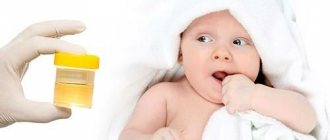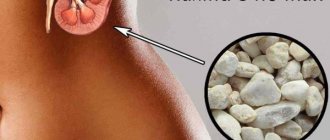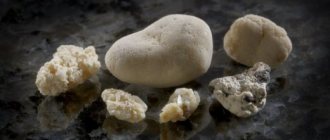Acute kidney injury (AKI) is defined (KDIGO 2012) as a clinical syndrome characterized by an increase in serum creatinine concentration of 0.3 mg/dL (26.5 mmol/L) over 48 hours, or a 1.5-fold increase in during the last 7 days, or urine output <0.5 ml/kg/h for 6 hours. Characterized by a wide range of disorders - from temporary increases in the concentration of biological markers of kidney damage to severe metabolic and clinical disorders (acute renal failure - AKI), requiring replacement renal therapy.
Classification of AKI severity is based on the magnitude of the increase in serum creatinine concentration and the rate of hourly urine output.
KDIGO severity classification of acute kidney injury (2012)
| Stage | Creatinemia | Diuresis |
| 1 | an increase of 1.5 to 1.9 times the baseline concentration, or ≥0.3 mg/dL (≥26.5 mmol/L) | <0.5 ml/kg/h for 6-12 h |
| 2 | increase 2.0-2.9 times compared to the initial concentration | <0.5 ml/kg/h for ≥12 h |
| 3 | increase 3 times the baseline concentration, or creatinemia ≥4.0 mg/dL (≥353.6 mmol/L), or initiation of renal replacement therapy | <0.3 ml/kg/h for ≥24 h or anuria for ≥12 h |
1. Prerenal AKI results from impaired renal perfusion. Causes:
- 1) decrease in the effective volume of circulating blood (hypovolemia) - bleeding, loss of fluid through the gastrointestinal tract (vomiting, diarrhea, surgical drainage), loss of fluid through the kidneys (diuretics, osmotic diuresis in diabetes mellitus, adrenal insufficiency), loss of fluid in the third space (acute pancreatitis, peritonitis, severe trauma, burns, severe hypoalbuminemia);
- 2) low cardiac output - disease of the heart muscle, valves and pericardium, cardiac arrhythmias, massive pulmonary embolism, mechanical ventilation with positive pressure;
- 3) disturbance of the tone of the renal and other vessels - generalized vasodilation (sepsis, arterial hypotension caused by antihypertensive drugs, including drugs that reduce cardiac afterload, general anesthesia), selective spasm of the renal vessels (hypercalcemia, norepinephrine, adrenaline, cyclosporine, tacrolimus, amphotericin B) , liver cirrhosis with ascites (hepatorenal syndrome);
- 4) renal hypoperfusion with impaired autoregulation - cyclooxygenase inhibitors (NSAIDs), ACE inhibitors (ACEIs), angiotensin receptor blockers (ARBs);
- 5) syndrome of increased blood viscosity - multiple myeloma, Waldenström macroglobulinemia, polycythemia vera;
- 6) occlusion of renal vessels (bilateral, or solitary kidney) - occlusion of the renal artery (due to atherosclerosis, thrombosis, embolism, dissecting aneurysm, systemic vasculitis), occlusion of the renal vein (due to thrombosis or external compression).
2. Renal AKI (parenchymal) is the result of damage to renal structures due to inflammatory and non-inflammatory causes. Causes:
- 1) primary lesions of the glomeruli and renal microvessels - glomerulonephritis, systemic vasculitis, thrombotic microangiopathy (hemolytic-uremic syndrome, thrombotic thrombocytopenic purpura), cholesterol crystal embolism, DIC, preeclampsia and eclampsia, malignant arterial hypertension, systemic lupus erythematosus, systemic scleroderma (scleroderma renal crisis);
- 2) acute damage to the renal tubules - impaired renal perfusion (long-term prerenal AKI), exogenous toxins (X-ray contrast agents, cyclosporine, antibiotics [eg, aminoglycosides], chemotherapeutic agents [cisplatin], ethylene glycol, methanol, NSAIDs, endogenous toxins (myoglobin, hemoglobin , monoclonal protein [eg, in multiple myeloma]);
- 3) tubulointerstitial nephritis - allergic (β-lactam antibiotics, sulfonamides, trimethoprim, rifampicin, NSAIDs, diuretics, captopril, bacterial infections (eg, Acute pyelonephritis), viral (eg, Cytomegalovirus) or fungal (candidiasis), infiltration by tumor cells (lymphoma, leukemia), granulomas (sarcoidosis), idiopathic;
- 4) obstruction of the renal tubules by crystals (rarely) - uric acid, oxalic acid (metabolite of ethylene glycol), acyclovir (especially with intravenous administration), methotrexate, sulfonamides, indinavir;
- 5) other rare causes - acute necrosis of the renal cortex, nephropathy after the use of Chinese herbs, acute phosphate nephropathy, warfarin nephropathy, removal of a single kidney;
- 6) acute kidney transplant rejection.
3. postrenal AKI - is the result of obstruction of the urinary tract (obstructive nephropathy). Causes:
- 1) obstruction of the ureters or ureter of a single kidney due to obstruction (stones in nephrolithiasis, blood clots, renal papillae), external compression (tumor, as a result of retroperitoneal fibrosis), disruption of the integrity of the ureter (false ligation or transection during surgery);
- 2) bladder diseases - neurogenic bladder, obstruction of the bladder outlet by a tumor (bladder cancer), stones, blood clots;
- 3) diseases of the prostate gland - benign tumor or cancer;
- 4) diseases of the urethra - obstruction by a foreign body or stone, trauma.
CLINICAL COURSE AND TYPICAL COURSE
Usually, subjective and objective symptoms of the underlying disease, which is the cause of AKI, predominate. Common symptoms of severe kidney failure are weakness, loss of appetite, nausea and vomiting. Oliguria/anuria occurs in ≈50% of cases of AKI, usually with prerenal AKI, renal cortical necrosis, bilateral renal artery thromboembolism or thromboembolism of the artery of a solitary kidney, thrombotic microangiopathy. Renal AKI may be accompanied by normal or even increased diuresis. In the typical course of AKI, 4 periods can be distinguished:
- 1) initial - from the onset of action of a harmful etiological factor to kidney damage; duration depends on the cause of AKI, usually within several hours;
- 2) oliguria/anuria - in ≈50% of patients, usually lasts 10-14 days;
- 3) polyuria - after a period of oliguria/anuria, the amount of urine increases sharply for several days. The duration of the period of polyuria is proportional to the duration of the period of oliguria/anuria and can last up to several weeks. During this period, dehydration and loss of electrolytes, especially potassium and calcium, may occur;
- 4) recovery, i.e. complete restoration of kidney function lasts several months.
In some patients, AKI is the onset of chronic kidney disease.
DIAGNOSIS
Supporting research
1. Blood test:
- 1) increased levels of creatinine and urea - the growth rate depends on the degree of kidney damage and the rate of their formation, which is significantly increased in a state of catabolism. In renal AKI, the daily increase in creatinine is 44-88 mmol/L (0.5-1.0 mg/dL). A daily increase in creatinemia >176 mmol/L (2 mg/dL) indicates increased catabolism and occurs in long-term compartment syndrome and sepsis; Significant acidosis and hyperkalemia usually then develop. Estimates of GFR using the Cockcroft and Gault formula or MDRD are not suitable. When assessing the dynamics of AKI, monitoring daily changes in creatinemia and urine output is most important;
- 2) hyperkalemia - as a rule, appears in cases of decreased diuresis. May be life-threatening (>6.5 mmol/L). Potassium concentration must be assessed in the context of acid-base balance, since acidosis leads to the release of K + from cells;
- 3) hypocalcemia and hyperphosphatemia - sometimes significant in long-term compression syndrome;
- 4) hypercalcemia in AKI associated with cancer (eg, Myeloma);
- 5) hyperuricemia - may indicate gout or tumor collapse syndrome;
- 6) increased activity of creatine phosphokinase (CPK) and myoglobin concentration - occurs with long-term contraction syndrome, muscle breakdown (eg, caused by statins);
- 7) arterial blood gasometry—metabolic acidosis;
 anemia is a characteristic sign of chronic renal failure; in case of AKI it can be a consequence of hemolysis or blood loss;
anemia is a characteristic sign of chronic renal failure; in case of AKI it can be a consequence of hemolysis or blood loss;- 9) thrombocytopenia - develops with hemolytic-uremic syndrome, thrombotic thrombocytopenic purpura, DIC syndrome.
2. Urine examination:
1) urine relative gravity may be >1.025 g/ml in prerenal AKI; in renal AKI, isosthenuria often develops;
2) proteinuria of varying degrees, especially when the cause is nephritis (glomerulonephritis or interstitial nephritis);
3) pathological components of urine sediment may indicate the cause of AKI:
- a) altered epithelial cells of the renal tubules, as well as granular casts and brown casts made up of them - with renal AKI;
- b) dimorphism of erythrocytes or leached erythrocytes and erythrocyte casts - indicate glomerulonephritis;
- c) eosinophilia in urine and blood (requires special staining for the drug) - indicates acute tubulointerstitial nephritis
- d) leukocyturia with positive results of microbiological examination of urine - may indicate acute pyelonephritis;
- e) fresh red blood cells and white blood cells - may appear in postrenal AKI.
3. ECG: signs of electrolyte disturbances may appear.
4. Imaging studies: ultrasound of the kidneys is routinely performed (in case of AKI, the kidneys are usually enlarged), X-ray of the chest (can reveal congestion in the pulmonary blood flow, fluid in the pleural cavities); other studies in case of special indications.
5. Kidney biopsy: performed only in cases of unclear diagnosis or if glomerulonephritis, systemic vasculitis or acute interstitial nephritis is suspected, when the result of the study may affect further treatment.
Diagnostic criteria
AKI is diagnosed based on:
1) rapid increase in creatinemia, i.e. by >2.5 mmol/L (0.3 mg/dL) in 48 hours or by ≥50% in the last 7 days, or
2) a decrease in the rate of diuresis <0.5 ml/kg body weight for > 6 subsequent hours (one of these criteria is sufficient).
Diagnosis of the cause of AKI is based on a detailed history, results of an objective examination and auxiliary studies.
Differential diagnosis of causes of AKI
The differential diagnosis between prerenal and renal AKI is important because in many cases rapid improvement in renal perfusion leads to normalization of renal function.
Indicators that help with differential diagnosis. Neither of them is suitable if AKI is superimposed on pre-existing chronic renal failure (CRF); differentiation in such cases. Postrenal AKI confirms urinary stagnation in the renal pelvis, ureters, and bladder, visualized by ultrasound. Selected differential features of prerenal and renal acute kidney injury (AKI)
| Prerenal AKI | Renal AKI | |
| volume of daily diuresis | <400 | miscellaneous |
| urine osmolality (mOsm/kg H2O) | > 500 | <400 |
| relative density of urine (g/ml) | > 1,023 | ≤1,012 |
| ratio of urea concentration (mg/dL) to serum creatinine concentration (mg/dL) | > 20 | <20 |
| ratio of urine creatinine concentration to serum creatinine concentration | > 40 | <20 |
| ratio of urine urea concentration to serum urea concentration | > 20 | <20 |
| Na concentration in urine (mmol/l) a | <20 | > 40 |
| Fractional excretion of Na filtrate would | <1% | > 2% |
| urine sediment | without pathology or transparent cylinders | epithelial cells, hyaline or epithelial cell casts |
| a urinary sodium concentration (to be determined before administration of furosemide) b FU Na (fractional excretion of sodium) = [(urinary Na concentration × serum creatinine concentration) / (serum Na concentration × urine creatinine concentration)] × 100% | ||
Selected differential features of acute kidney injury (AKI) and chronic renal failure (CRF)
| AKI | chronic renal failure | |
| medical history suggests chronic kidney disease | neither | So |
| kidney sizes | normal | small |
| dynamics of increase in creatinemia | high | low |
| blood morphology | fine | anemia |
| phosphorus-calcium metabolism | impairment of moderate or moderate intensity (depending on the etiology of AKI) | high phosphate concentration and increased alkaline phosphatase activity, radiological signs of renal osteodystrophy and/or soft tissue calcification |
| ocular fundus | mostly unchanged | there are often changes characteristic of diabetes mellitus or chronic arterial hypertension |
What is Acute Kidney Injury (AKI)
Acute kidney injury is not the result of a physical blow to the kidneys, as the name might suggest.
This type of kidney damage is usually seen in older people who are unwell with other conditions and the kidneys are also affected.
It is important that AKI is detected early and treated promptly. The role of the kidneys is to:
- filter - removing waste water from the blood (like urine, through the bladder)
- cleanses the blood
- keeps bones healthy
- monitors blood pressure
- stimulates the bone marrow to make blood
Without prompt treatment, abnormal levels of salts and chemicals can build up in the body, which affects the ability of other organs to work properly.
If the kidneys shut down completely, it may require temporary support from a dialysis machine or result in death.
How is the severity of CKD classified?
There are five stages in total. They are divided according to the glomerular filtration rate (GFR), which is calculated by blood creatinine, as well as the amount of daily proteinuria. This is a minimum of tests that should be repeated to the patient.
Blood test for creatinine. In the simplest case, the doctor calculates GFR using a standard formula. But there are cases (very obese, very emaciated people who have lost a limb, paralyzed people, pregnant people, that is, with non-standard weight) when it is best to perform the so-called Rehberg test.
To do this, you need to collect urine one day before, measure its volume the next morning, write down the patient’s height, weight, duration of collection, and, before pouring it into a jar, be sure to shake the daily dose. Take the jar not to the general laboratory, but to the biochemical laboratory, where they will take your blood for creatinine that same morning. This is a direct calculation method to determine how much creatinine is filtered from the blood into the urine.
Analyze the same daily urine to determine proteinuria (microalbuminuria), that is, the amount of protein lost per day. Be sure to shake the urine in this case as well, otherwise all the protein will settle to the bottom.
Acute kidney injury (AKI) Symptoms
In the early stages of AKI, there may be no symptoms. The only possible warning sign may be that the person is not producing much urine, although this is not always the case.
Someone with AKI may quickly worsen and suddenly experience any of the following:
- nausea and vomiting
- dehydration
- confusion
- decreased output of urine (urine) or changes to the color of urine
- high blood pressure
- abdominal pain
- slight back pain
- accumulation of fluid in the body (edema)
Even if it does not progress to complete kidney failure, AKI must be taken seriously.
Who is at risk for acute kidney injury
You are more likely to get AKI if:
- You are 65 years of age or older.
- You already have kidney problems, such as chronic kidney disease.
- You have a long-term condition such as heart failure, liver disease, or diabetes.
- You are dehydrated or unable to maintain fluid intake You have (or are at risk of) a blockage in your urinary tract.
- You have a severe infection or sepsis.
- You take certain medications, including nonsteroidal anti-inflammatory drugs (NSAIDs, such as ibuprofen) or blood pressure medications, such as ACE inhibitors or diuretics. Diuretics are generally beneficial for the kidneys, but may become less beneficial when a person is dehydrated or has a severe illness.
- You receive an aminoglycoside, a type of antibiotic; again, this is only a problem if the person is dehydrated or sick, and they are usually only given in a hospital setting.
AKI can affect both adults and children.
What other general and medicinal measures should be taken?
- Restriction of animal protein (0.8 - 1.0 g per kg of body weight per day), with GFR less than 30 - no more than 40 g per day. One of the justifications for strictly limiting animal protein in stage 4 CKD is the accumulation in the blood of so-called “nitrogenous wastes, products of protein breakdown. In healthy people they are easily excreted in the urine, but in sick people they accumulate, poisoning the body. So, by following a low-protein diet, we fight the consequences to the best of our ability, but do not affect the kidney disease itself.
- With a low-protein diet at the 4th stage, it is necessary to add the so-called keto analogs of amino acids ( ketosteril ) 4-8 tablets 3 times a day (only if a low-protein diet is followed). They supply the body with the necessary nutrients that it is deprived of during such a strict diet. They are often given out free of charge with a prescription from a nephrologist.
- Correction of dyslipidemia - determine the level of total cholesterol, low-density lipoproteins (LDL) and high-density lipoproteins (HDL), triglycerides. The cholesterol norm for such patients is no more than 4.5 mmol/l, LDL is no higher than 2.5 mmol/l, and often requires a reduction to 1.8-2.1 mmol/l, triglycerides are below 1.8 mmol/l , HDL should be above 1.2 mmol/l. rosuvastatin is now considered the most active , on average 10 mg per day.
- Avoid the use of nephrotoxic drugs (antibiotics from the aminoglycoside group - for example gentamicin, non-steroidal anti-inflammatory drugs - any, from diclofenac to meloxicam , including, without exaggeration, more than a dozen names).
- Caution when performing radiopaque procedures.
- Correction of renal anemia. Of course, it can be of any nature, be iron- or B12-deficient. But most often it is caused by a violation of the synthesis in the kidneys of a substance necessary for hematopoiesis. That is why she is treated with recombinant human erythropoietin preparations, these are injections. Without a proven deficiency, iron and vitamin supplements should not be used blindly. The target hemoglobin level is 100-110 g/l; there is no need to raise it to normal.
By the 4th stage, disturbances in potassium and calcium-phosphorus metabolism become obvious. In addition to blood creatinine and GFR calculation, determination of daily protein loss, control of lipids, blood pressure, glycated hemoglobin and detection of anemia, new tests become necessary at this stage: potassium, sodium, calcium - total ionized, phosphorus, parathyroid hormone (PTH), vitamin D. It is also worth taking a survey of the hands, arms and pelvis in order to identify calcified vessels on them.
- Potassium correction. Alas, there is a misconception among people that potassium is always useful; people forget that everything is good in moderation. The “measure” of potassium (normal) is 3.5-5 mmol/l, an increase to 6 is considered mild and requires only a diet. Most potassium is found in dried fruits and quickly cooked (baked, chips) potatoes. But there is a lot in any fresh fruit (especially bananas), vegetables (I’ll highlight tomatoes), and yogurt. This is exactly what has to be limited. Potassium levels above 6.5-7.0 are considered severe and require emergency hemodialysis!
- It is very important to correct phosphorus-calcium metabolism, since this disorder not only does not go away, but also progresses during hemodialysis, affecting both well-being and life prognosis. But this task is difficult, since at least 3 indicators are assessed - calcium, phosphorus and parathyroid hormone.
Acute kidney injury (AKI) Causes
Most cases of AKI are caused by decreased blood flow to the kidneys, usually in those who are already sick with another health condition.
This reduced blood flow could be caused by:
- Low blood volume after bleeding, excessive vomiting or diarrhea, or as seen with severe dehydration.
- The heart pumps out less blood than usual as a result of heart failure, liver failure or sepsis, for example.
- Blood vessel problems—such as inflammation and blockage of blood vessels within the kidneys (a rare condition called vasculitis).
- Some medications (see above) may affect the blood supply to the kidney - other medications may cause unusual reactions in the kidney itself.
Algorithm for emergency care and intensive care
Emergency care for the diagnosis of acute renal failure consists primarily of prompt delivery of the patient to the hospital clinic.
Initially, it is important for him to create the very first favorable conditions for him: to ensure peace and warmth, the patient’s body should be in a horizontal position.
In any case, you need to call an ambulance , so the specialists on the spot will take all the necessary measures.
In case of serious condition, the patient must be taken to the clinic. Any treatment is prescribed after determining the type of disease and the cause that caused it.
After getting rid of the cause, you need to restore homeostasis and the process of urine excretion by the kidneys.
Depending on the factors involved in the development of AKI, antibiotics for infections and fluid replacement may be required.
It is necessary to use diuretics to reduce fluid and relieve swelling, and increase the volume of urine excreted. Medicines are prescribed for heart failure to lower blood pressure.
Surgery may be necessary to repair kidney tissue and remove the cause of urethral blockage after traumatic injury.
Medicines are taken to normalize the blood supply; in case of intoxication of the body due to poisoning, the stomach must be rinsed or antidotes administered.
To remove toxins from the blood use the following:
- blood purification through a membrane using an “artificial kidney” device,
- plasmapheresis,
- purification of blood from exogens and endogens,
- extrarenal blood purification by absorption of poison on the surface of the sorbent.
To , acid and electrolytes in the blood,
All these procedures are applied until the kidneys are restored and perform their functions . With timely treatment, one can hope for a favorable outcome.
Acute kidney injury Treatment
Treatment for AKI depends on the underlying cause and extent of the disease. In most cases, treating the underlying problem will cure AKI.
GPs may be able to manage mild cases in people who are not yet in hospital. They can … :
- It is advisable to stop any medications that may be causing the situation or making it worse - it may be safe to restart some of them once the problem has resolved. (Cancellation of life-saving medications occurs only after the doctor's permission).
- Treat any underlying infections.
- Stay on fluid intake to prevent dehydration (which could cause or worsen AKI).
- Take blood tests to monitor creatinine and salt levels - to check how well a person is recovering.
- See a urologist (genitourinary surgeon) or nephrologist (kidney specialist) if the cause is unclear or if a more serious cause is suspected.
Diagnosis of the disease
To diagnose AKI, an initial examination by a doctor and a number of mandatory laboratory and instrumental tests are required.
Blood chemistry:
- Determination of the level of metabolic end products in the blood. The most specific indicator is the amount of creatinine. The higher it is, the more severe the degree of decline in renal function is diagnosed.
- Establishing the level of blood acidity (detection of acidosis).
Urine tests - general and biochemical. Impaired kidney function is indicated by increased levels of potassium and phosphorus, and decreased levels of sodium.
Hardware studies: ultrasound and CT (computed tomography). They are done to visualize the size of the kidneys and bladder, the presence of hydronephrosis (fluid in the kidneys), and urinary tract obstructions.
 anemia is a characteristic sign of chronic renal failure; in case of AKI it can be a consequence of hemolysis or blood loss;
anemia is a characteristic sign of chronic renal failure; in case of AKI it can be a consequence of hemolysis or blood loss;








